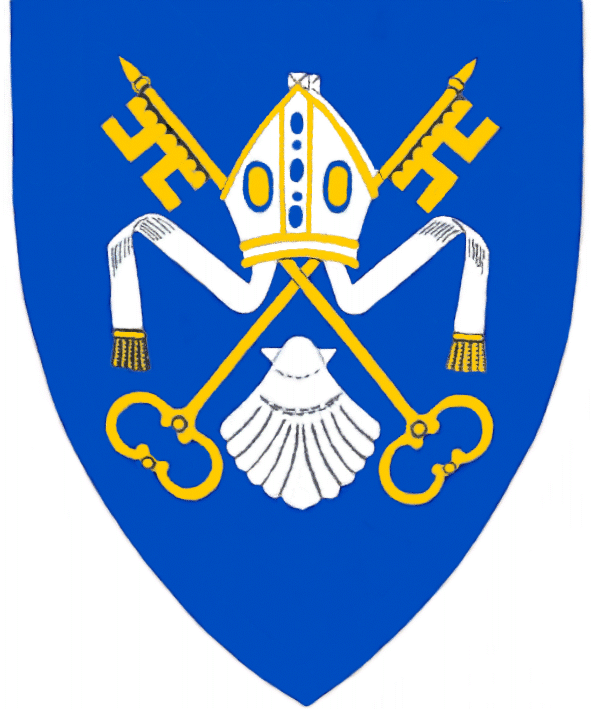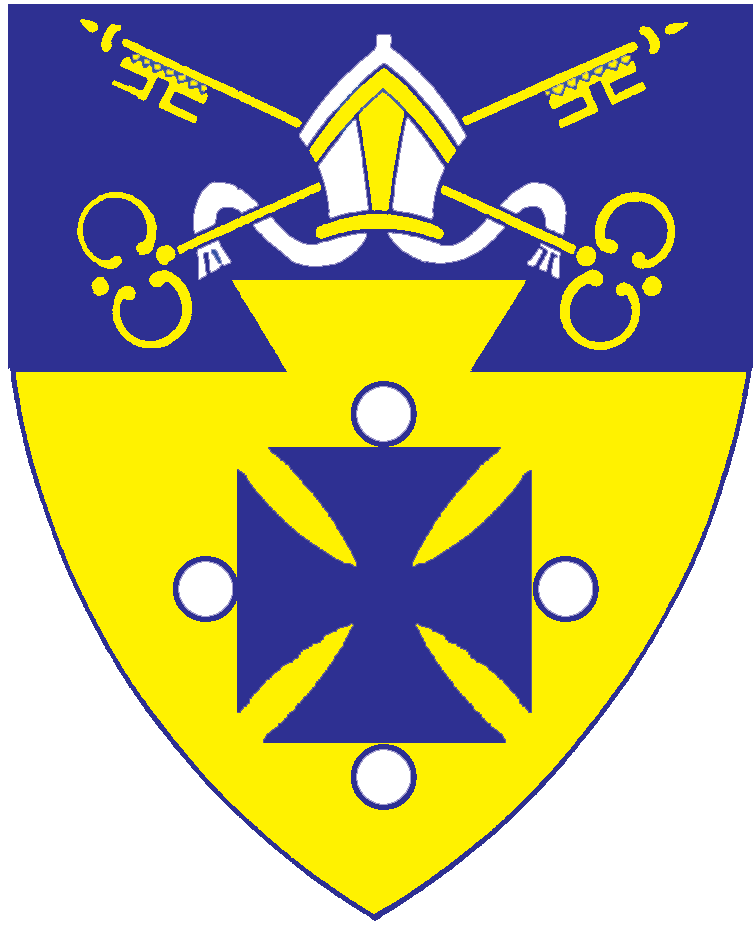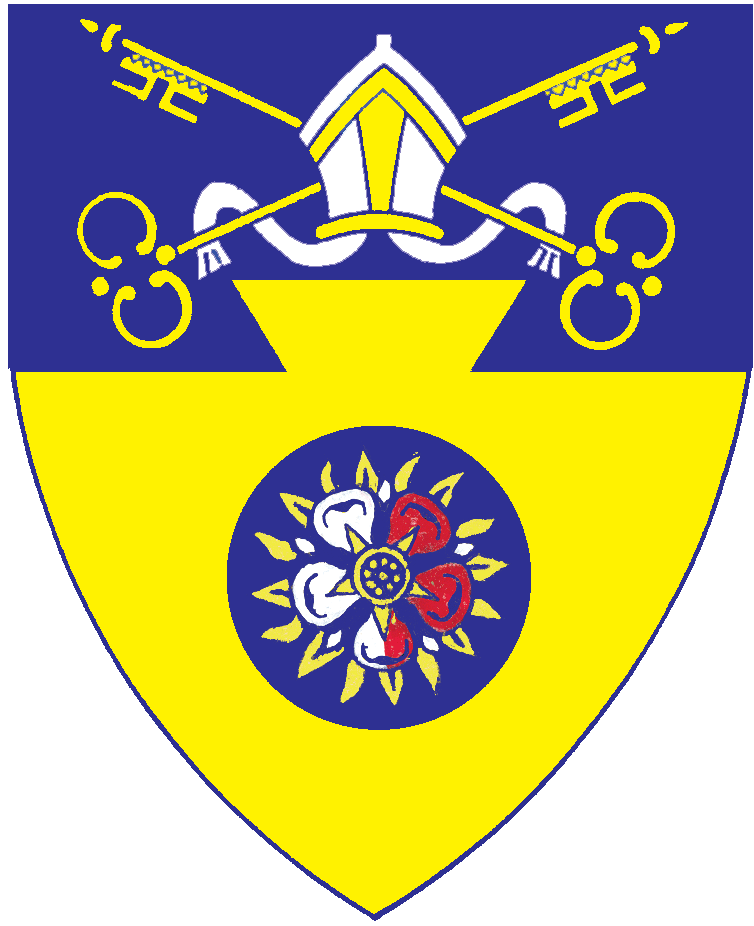

ALLAN WEBB HALL, Rhodes University, Grahamstown.
Afrikaanse blasoene

RHODES University’s residences are organised into halls: between three and six houses will share a dining hall. The hall named for Allan Becher Webb, third Anglican Bishop of Grahamstown (in this office 1885-1895), occupies what for many years was the Grahamstown Training College, which operated under the auspices of (and was owned by) the Community of the Resurrection of Our Lord, an Anglican order of nuns founded in Grahamstown by Cecile Isherwood (Mother Cecile) at the instigation of Bishop Webb.
The hall – which stands on what is known as St Peter’s Campus – has a distinctly ecclesiastical flavour to it, which is reflected in the arms of the hall itself, and of the four houses, each of which incorporates an episcopal mitre and, crossed saltirewise behind it, the keys of St Peter. The Training College, with its religious foundation, naturally incorporated a chapel, the Chapel of St Mary and All the Angels, which today serves the whole university.
It is understood that these five coats of arms were registered with the Bureau of Heraldry in Pretoria. (Records of registration appear to have been mislaid, but this is being gone into.)
The arms of Allan Webb Hall may be blazoned:
Azure, two keys in saltire Or between, in chief a mitre Argent embellished Or and Azure and, in base an escallop also Argent.
The website of Allan Webb Hall explains that the scallop shell “is taken from the arms of Rhodes University to emphasise that the Hall is an integral part of the University”. It adds: “The escallop was also the medieval symbol of the pilgrim, and by an extension of this concept, may be seen as symbolising the students of the Hall as being pilgrims seeking knowledge.”
The three scallops in the university coat of arms are taken in turn from the arms of Grahamstown and from the arms of Graham of Fintry.
The arms of the four houses follow a common pattern: the mitre and keys are accommodated on a chief (blazoned as being escartelly dovetailed), with the main field containing a symbol unique to each house. Escartelly means that there is a step (up and down) in the middle of the line of division; dovetailed describes the shape of that step. The step itself (which if straight-lined could also be blazoned as quadrate) rises by one-third of the shield’s width.
The arms of the four houses are:


Canterbury House:
Or, a cross paty Azure having conjoined to each arm a plate fimbriated Azure; on a chief escartelly dovetailed also Azure two keys in saltire Or surmounted by a mitre Argent embellished Or.
A cross paty is one with broad arms. The word plate is a special name for a silver or white roundel; fimbriated means having an outline of the colour named (blue). The cross is taken from the arms of the Archbishop of Canterbury.
Truro House:
Or, a fleur de lis Azure; on a chief escartelly dovetailed also Azure two keys in saltire Or surmounted by a mitre Argent embellished Or.
A fleur de lis appears in the arms of the Diocese of Truro in Cornwall.[1]


Salisbury
House:
Or, a diadem consisting of five rays Azure issuing from a circlet Argent embellished Azure; on a chief escartelly dovetailed also Azure two keys in saltire Or surmounted by a mitre Argent embellished Or.
A diadem like this appears in the arms of the Diocese of Salisbury in England. It also resembles the heraldic charge called an eastern crown, which is thought suitable for a house located in the Eastern Cape Province (and which once formed part of the Eastern Province of the Cape Colony).
Winchester
House:
Or, upon a roundel Azure a sun of sixteen rays, whereupon a rose per pale Argent and Gules, seeded and barbed Or; on a chief escartelly dovetailed also Azure two keys in saltire Or surmounted by a mitre Argent embellished Or.
The rose en soleil in these arms is an adaptation of one of the charges appearing in the coat of arms of the Dean and Chapter of Winchester Cathedral in England.
Afrikaanse blasoene:
Bogenoemde wapens mag in Afrikaans so geblasoeneer word:
Canterbury-huis:
In goud, ’n breedarmige kruis van silwer met aan die punt van elke arm ’n silwer penning, blou omlyn; op ’n skildhoof duifstert-kwadraat ook van blou, twee sleutels skuins gekruis, en in die voorgrond ’n biskopsmus van silwer, goud versier.
Truro-huis:
In goud, ’n lelie van blou; op ’n skildhoof duifstert-kwadraat ook van blou, twee sleutels skuins gekruis, en in die voorgrond ’n biskopsmus van silwer, goud versier.
Salisbury-huis:
In goud, ’n kroon van vyf strale wat uit ’n ring oprys, van silwer met blou versier; op ’n skildhoof duifstert-kwadraat ook van blou, twee sleutels skuins gekruis, en in die voorgrond ’n biskopsmus van silwer, goud versier.
Winchester-huis:
In goud, op ’n koek van blou ’n son van sestien strale, waarop ’n roos gedeel van silwer en rooi, met sade en blare van goud; op ’n skildhoof duifstert-kwadraat ook van blou, twee sleutels skuins gekruis, en in die voorgrond ’n biskopsmus van silwer, goud versier.
